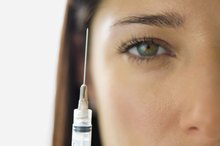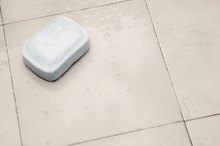How to Freeze Skin Moles
According to MayoClinic.com, the skin's pigment-producing melanocytes usually distribute color evenly throughout the surface of your skin. Sometimes, however, clusters of pigmented cells develop, resulting in dark spots commonly called moles. Moles can appear in a variety of colors ranging from red to dark brown, and can be flat or protruding, round or oval. While they are generally harmless, some people may want to remove them for cosmetic reasons. Also, some protruding moles may be prone to irritation if they are located in an area where they are frequently rubbed by clothing or nicked by razors. Cryotherapy uses liquid nitrogen to freeze unwanted skin lesions 1. The procedure generates few side effects and can be completed quickly in your doctor's office.
Consider the side effects associated with cryotherapy 1. Immediate side effects may include swelling or blistering of the treatment area, and on rare occasions, infection can occur. The treated area may also differ in color from the surrounding skin, particularly with darker skinned individuals. The discoloration may fade over time, or it may be permanent. Also, numbness in the area can occur if a superficial nerve is frozen. If this occurs, sensation to the affected area returns in a few months.
How to Remove Age Spots & Brown Spots by Freezing
Learn More
Schedule an appointment with your dermatologist or general practitioner. Your physician conducts the cryotherapy procedure in her office in a matter of minutes 1. Using a special spray gun, she applies liquid nitrogen to the mole. Anesthesia is not usually administered, however, if you are pain-sensitive, the British Association of Dermatologists recommends that you take an analgesic an hour before the procedure to reduce pain.
Take an over-the-counter painkiller to reduce pain. The British Association of Dermatologists asserts that pain at the treatment site is likely for the 24-hour period following your cryotherapy treatment, and an analgesic, such as acetaminophen can minimize discomfort 1.
Derma Filler Side Effects
Learn More
Expect a blister to form on the treated area. DermNet NZ, the New Zealand Dermatological Society website, asserts that blistering is likely after undergoing cryotherapy 1. Within a few days, however, the blister with subside and a scab will develop. Allow the scab to slough off on its own, and avoid picking or scratching it to lessen the likelihood of scarring. Also, the the treated area is likely to be rubbed by clothing, keep it covered with bandages.
Keep the area clean. Wash the treated skin once or twice a day, and pat dry. The British Association of Dermatology also recommends that you apply petroleum jelly once the scab has formed.
Related Articles
References
Writer Bio
Based in Los Angeles, Claire McAdams has been writing professionally since 2006. Her work has appeared in "The Tennessean" and also online at MaestroCompany.com and SoCal.com. She holds a Bachelor of Music Degree from Belmont University and a Bachelor of Arts Degree in History and Political Science from King College.









